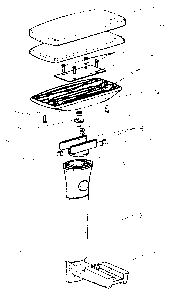Some of the information on this Web page has been provided by external sources. The Government of Canada is not responsible for the accuracy, reliability or currency of the information supplied by external sources. Users wishing to rely upon this information should consult directly with the source of the information. Content provided by external sources is not subject to official languages, privacy and accessibility requirements.
Any discrepancies in the text and image of the Claims and Abstract are due to differing posting times. Text of the Claims and Abstract are posted:
| (12) Patent Application: | (11) CA 2440490 |
|---|---|
| (54) English Title: | ARMREST |
| (54) French Title: | ACCOUDOIR |
| Status: | Deemed Abandoned and Beyond the Period of Reinstatement - Pending Response to Notice of Disregarded Communication |
| (51) International Patent Classification (IPC): |
|
|---|---|
| (72) Inventors : |
|
| (73) Owners : |
|
| (71) Applicants : |
|
| (74) Agent: | NORTON ROSE FULBRIGHT CANADA LLP/S.E.N.C.R.L., S.R.L. |
| (74) Associate agent: | |
| (45) Issued: | |
| (22) Filed Date: | 2003-09-08 |
| (41) Open to Public Inspection: | 2004-04-04 |
| Examination requested: | 2008-09-03 |
| Availability of licence: | N/A |
| Dedicated to the Public: | N/A |
| (25) Language of filing: | English |
| Patent Cooperation Treaty (PCT): | No |
|---|
| (30) Application Priority Data: | ||||||
|---|---|---|---|---|---|---|
|
In the case of a chair, in particular a swivel chair
for the office, the armrest is made up of an armrest
carrier, which comprises a carrier (1) and a sleeve (2)
sliding thereon and is attached to the seat at the
bottom by a seat flange (3) which can be displaced
transversely to the seat direction, and of an arm
support (10, 11), which can. be displaced longitudinally
via a guide (7) and can be rotated via a rotary part
(4) mounted in a rotary bearing (5). The guide (7) is
arranged parallel, but eccentrically in relation, to
the axis of symmetry of the arm support. Since the
rotatability of the arm support is at least 180°, it is
possible to set different clear distances between the
two arm supports (10, 11) of the chair.
Note: Claims are shown in the official language in which they were submitted.
Note: Descriptions are shown in the official language in which they were submitted.

2024-08-01:As part of the Next Generation Patents (NGP) transition, the Canadian Patents Database (CPD) now contains a more detailed Event History, which replicates the Event Log of our new back-office solution.
Please note that "Inactive:" events refers to events no longer in use in our new back-office solution.
For a clearer understanding of the status of the application/patent presented on this page, the site Disclaimer , as well as the definitions for Patent , Event History , Maintenance Fee and Payment History should be consulted.
| Description | Date |
|---|---|
| Inactive: Dead - Final fee not paid | 2012-06-13 |
| Application Not Reinstated by Deadline | 2012-06-13 |
| Deemed Abandoned - Failure to Respond to Maintenance Fee Notice | 2011-09-08 |
| Deemed Abandoned - Conditions for Grant Determined Not Compliant | 2011-06-13 |
| Notice of Allowance is Issued | 2010-12-13 |
| Letter Sent | 2010-12-13 |
| Notice of Allowance is Issued | 2010-12-13 |
| Inactive: Approved for allowance (AFA) | 2010-12-09 |
| Amendment Received - Voluntary Amendment | 2010-08-03 |
| Inactive: S.30(2) Rules - Examiner requisition | 2010-02-18 |
| Letter Sent | 2008-10-27 |
| Request for Examination Received | 2008-09-03 |
| Amendment Received - Voluntary Amendment | 2008-09-03 |
| All Requirements for Examination Determined Compliant | 2008-09-03 |
| Request for Examination Requirements Determined Compliant | 2008-09-03 |
| Inactive: IPC from MCD | 2006-03-12 |
| Inactive: Filing certificate correction | 2004-07-27 |
| Inactive: Office letter | 2004-06-02 |
| Inactive: Filing certificate - No RFE (English) | 2004-05-31 |
| Application Published (Open to Public Inspection) | 2004-04-04 |
| Inactive: Cover page published | 2004-04-04 |
| Inactive: Correspondence - Transfer | 2004-02-04 |
| Letter Sent | 2004-01-23 |
| Letter Sent | 2004-01-23 |
| Inactive: Single transfer | 2003-12-04 |
| Inactive: First IPC assigned | 2003-11-03 |
| Inactive: Courtesy letter - Evidence | 2003-10-14 |
| Inactive: Filing certificate - No RFE (English) | 2003-10-06 |
| Filing Requirements Determined Compliant | 2003-10-06 |
| Application Received - Regular National | 2003-10-03 |
| Abandonment Date | Reason | Reinstatement Date |
|---|---|---|
| 2011-09-08 | ||
| 2011-06-13 |
The last payment was received on 2010-08-24
Note : If the full payment has not been received on or before the date indicated, a further fee may be required which may be one of the following
Please refer to the CIPO Patent Fees web page to see all current fee amounts.
| Fee Type | Anniversary Year | Due Date | Paid Date |
|---|---|---|---|
| Application fee - standard | 2003-09-08 | ||
| Registration of a document | 2003-12-04 | ||
| MF (application, 2nd anniv.) - standard | 02 | 2005-09-08 | 2005-08-31 |
| MF (application, 3rd anniv.) - standard | 03 | 2006-09-08 | 2006-08-25 |
| MF (application, 4th anniv.) - standard | 04 | 2007-09-10 | 2007-08-24 |
| MF (application, 5th anniv.) - standard | 05 | 2008-09-08 | 2008-08-28 |
| Request for examination - standard | 2008-09-03 | ||
| MF (application, 6th anniv.) - standard | 06 | 2009-09-08 | 2009-08-31 |
| MF (application, 7th anniv.) - standard | 07 | 2010-09-08 | 2010-08-24 |
Note: Records showing the ownership history in alphabetical order.
| Current Owners on Record |
|---|
| SEDUS STOLL AG |
| Past Owners on Record |
|---|
| KLAUS MAIER |
| MICHAEL KLASENER |
| THOMAS STENZEL |